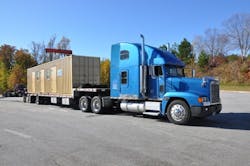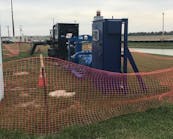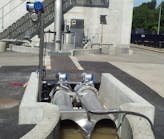AdEdge Water Technologies LLC
undefined
After discovering its three wells contained excessive levels of arsenic, the Spring Creek Utilities Co. hired Sunrise Eng. to help develop a solution. The engineering firm contracted with AdEdge Water Technologies in June 2011 after a competitive bidding process, to design, manufacture and start up an arsenic treatment solution as quickly and economically as possible.
The Spring Creek Utilities Co. provides water service to 1,500 residents in Spring Creek, Nev., outside the city of Elko, Nev., in a sparsely populated northeast portion of the state. Its water system consists of three wells that feed into a centralized distribution system: Well #1 receives water at a maximum flow of 435 gpm, well #3 at a maximum flow of 725 gpm and well #11 at a maximum flow of 720 gpm, for a combined maximum capacity of 1,950 gpm, or 2.8 mgd.
The water in these wells were found to have average arsenic levels ranging from 19 ppb to 35 ppb, well in excess of the Nevada Division of Environmental Protection’s (NDEP) maximum contaminant level of 10 ppb. The U.S. Environmental Protection Agency (EPA) and NDEP had ordered Spring Creek to address this problem within six months.
“There was no time to design and construct a conventional facility,” said Greg Gilles, vice president and principal of AdEdge. “One of the things that helped them to select us was our experience with arsenic treatment, and that we could deliver the system in the timeframe they needed.”
Solution
AdEdge provided five 40-ft.-long WaterPOD containerized units: one custom-designed unit for well #1, and two each for wells #3 and #11. Each unit includes HVAC, pedestrian doors, vents, windows and lighting—and, most importantly, an AdEdge GS+ coagulation/ filtration package that is sized for the well’s maximum flow. These units sit on concrete slab bases and are pre-designed and pre- piped, ready for “plug and play” use.
“Being able to have something that just rolls off a truck, you plug and play and it’s ready to roll, saved a lot of time for us,” said Kevin Brown, civil engineering manager on the project for Sunrise Eng.
The treatment process begins in the well house, where a chlorine module injects liquid sodium hypochlorite into the water. This oxidizes arsenic (III) to arsenic (V) to aid in its removal. The water is then injected with ferric chloride to supplement the raw water iron concentration in order to further assist in arsenic removal. From there, the water is treated with CO2 to reduce its pH level to approximately 7, as adsorbent media and coagulation/filtration processes are typically more effective in waters with pH levels of 6.8 to 7.3.
After pH level is reduced, the water is introduced to the WaterPOD and treated using 26 cu ft of AdEdge GS+ coagulation/ filtration media, housed in carbon-steel vessels (seven at well #1’s WaterPOD, and six each at the other two wells) in a parallel configuration. AdEdge GS+ is an NSF 61-certified black filter media used for arsenic, iron and manganese removal. Its surface is coated with manganese dioxide, which acts as a catalyst in the oxidation-reduction reaction of iron, arsenic and manganese. The treated water is then stored in an atmospheric tank.
Each system features automated control valves and harnesses, a central control panel with a programmable logic controller (PLC) and a color user interface screen. They also include differential pressure systems; control panel with local gauges, flow sensors and totalizers; and central hydraulic panel with sample ports.
The facility backwashes these systems every two to three days in order to remove any suspended solids that accumulate in the bed and to hydraulically fluff the bed to prevent channeling. AdEdge also provided an H2Zero backwash reclamation system that reclaims 99.8% of the settled backwash water. The settled suspended solids form a low-percent- solids sludge that can be dewatered and removed to a solid waste landfill.
Results
The systems started up in December 2011, with all three wells feeding into an overall integrated treatment system that manages the maximum capacity of 1,950 gpm. “It was easy to get the site ready and get the technology up and running. From an engineer’s standpoint, it couldn’t have been any better,” said Brown.
Since this treatment process was initiated, the arsenic levels in water from all three wells have been reduced to fewer than 2 ppb—far below the NDEP’s maximum contaminant level.



